|
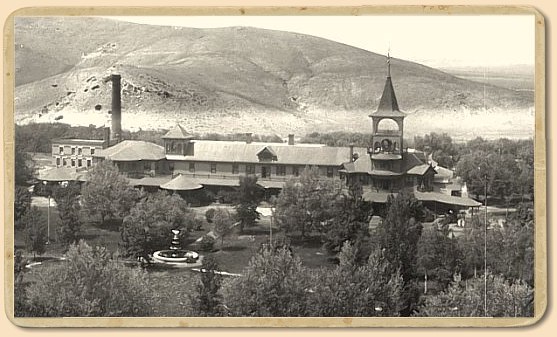
The
cottage-style hotel was designed by the firm of Wallace, Thornburgh
& Appleton.
View looking north, ca. 1908
LIBRARY
OF CONGRESS
The
hotel was outfitted in luxurious Victorian style,
with elaborate woodwork, stained glass windows, cut crystal
and oriental carpets. As one early visitor described it:
"The verandahs were long and wide, the park was dotted
with fountains, and the interior of the hotel was luxurious
in all it's furnishings. Elegantly appointed bathrooms in
the hotel offered at one's pleasure the double spray plunge,
vapor, and needle baths."
Fine cuisine was served in the
elegant restaurant. There were sitting parlors, and
a bar and billiard room. A
wooden spiral staircase led up to a steepled observation
cupola, rising several stories above the roof. |
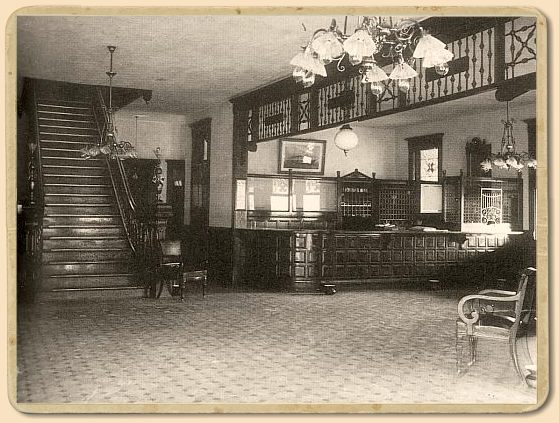
The
hotel lobby
MONTANA
HISTORICAL SOCIETY
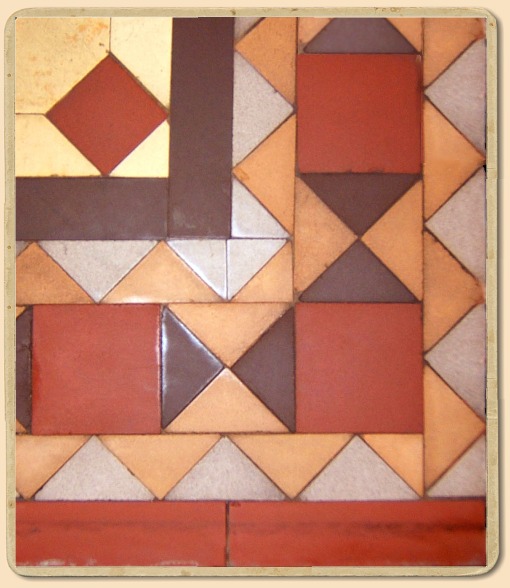
Floor
tile fragment from the hotel lobby
PARTIALLY DIGITALLY RESTORED
- COURTESY
OF SCOTT NELSON - THE
BRIDGEWORKS CONSERVANCY
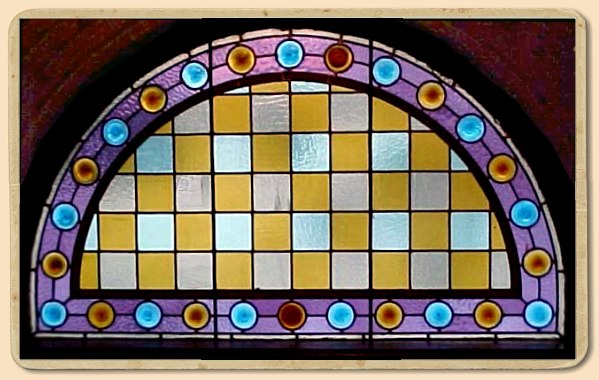
Arched
stained glass window
photographed in situ, 1974.
PHOTO
COURTESY OF SCOTT NELSON - THE
BRIDGEWORKS CONSERVANCY
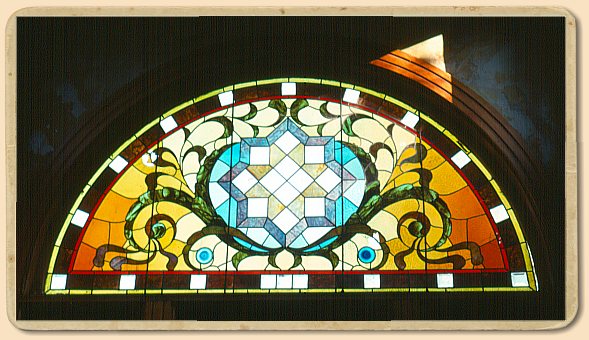
Arched
stained glass window
photographed in situ, 1974.
One of a pair, they were located on the rear (north side) of
the hotel.
PHOTO
COURTESY OF SCOTT NELSON - THE
BRIDGEWORKS CONSERVANCY
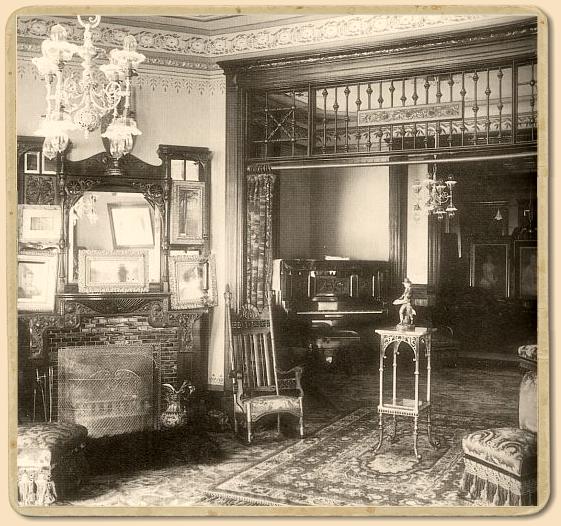
A parlor
MONTANA
HISTORICAL SOCIETY
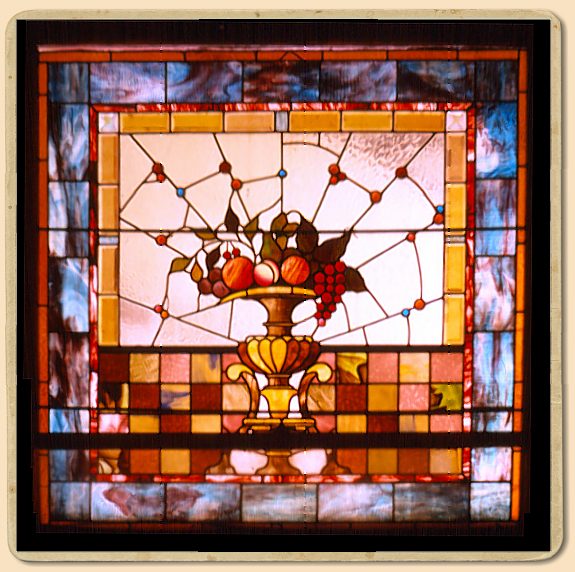
"The
Cornucopia" stained glass window,
photographed in situ, 1974.
PHOTO
COURTESY OF SCOTT NELSON - THE
BRIDGEWORKS CONSERVANCY
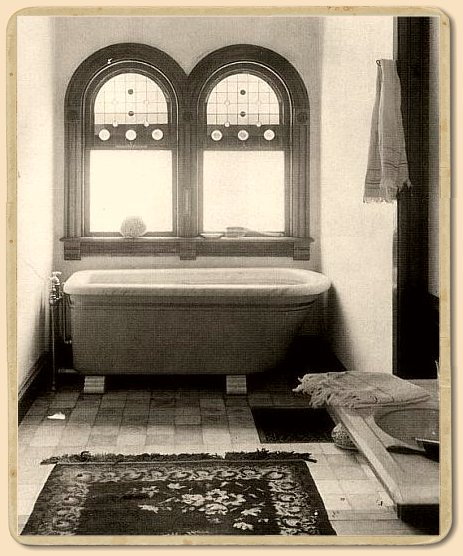
A
luxurious bath
MONTANA
HISTORICAL SOCIETY
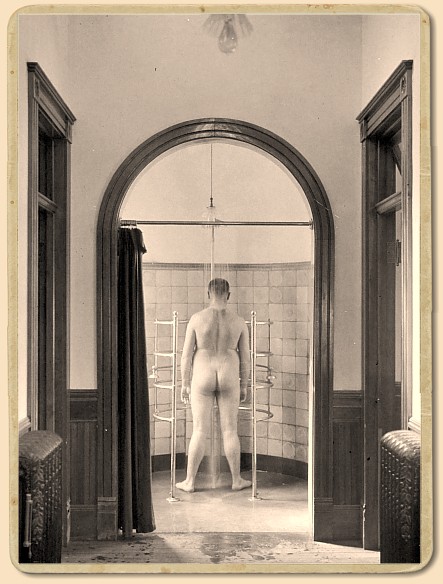
A
needle bath aka "Universal Douche" •
CLICK FOR A DETAILED VIEW
PHOTO
COURTESY OF SCOTT NELSON - THE
BRIDGEWORKS CONSERVANCY

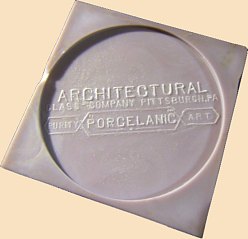
REVERSE OF
TILE
Porcelanic
Architectural tiles
from the needle bath, recovered from an
old refuse heap near the hotel site.
COURTESY OF SCOTT NELSON
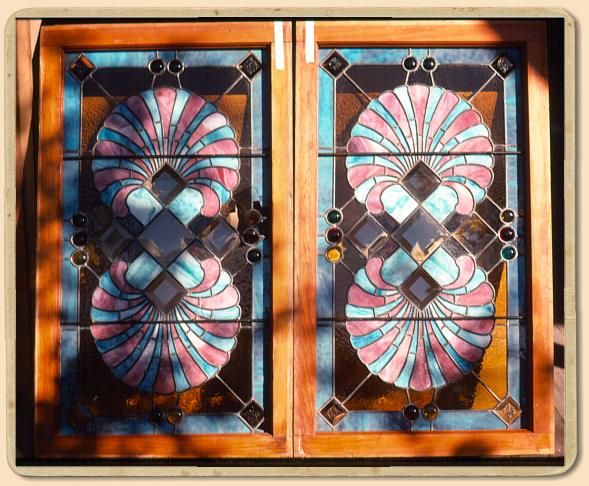
Shell
windows at the 1974 auction.
PHOTO
COURTESY OF SCOTT NELSON - THE
BRIDGEWORKS CONSERVANCY
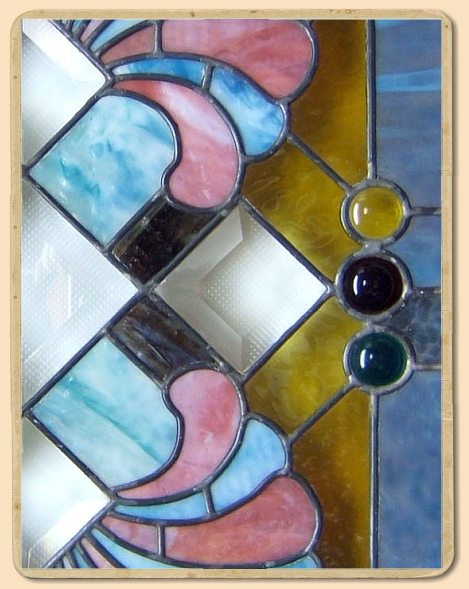
Shell
window detail
PHOTO
COURTESY OF SCOTT NELSON - THE
BRIDGEWORKS CONSERVANCY
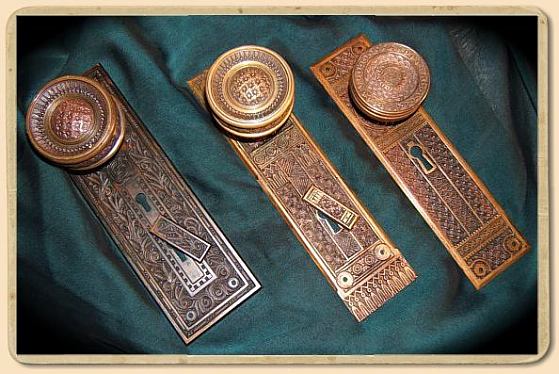
CLICK ON
THE KEYHOLES FOR LARGER IMAGES OPENING IN NEW WINDOWS
Corbin
Lock Co. door hardware from the Broadwater Hotel.
Scott Nelson of Helena explains:
|
The
center and right are examples of Corbin's "Brocade"
designs, They are regarded by most as the most refined
and highest detailed of the Brocade patterns. All three
pieces were manufactured circa 1887, and were available
until 1901.
The center example is the type used on the many exterior
doors and heavy traffic areas. There were approximately
12 sets of these, and are highly collectible in Helena.
The pattern on the right is considered the "common",
though I would still give almost anything to own it. It
was the type of pattern seen throughout the Hotel for
the majority of room doors
and closets.
On
the left, the heavy bronze main entry set has the "Irish
Leaf" pattern. It was used on all major door work,
including the two sets of massive 300lb pocket doors that
separated the ladies parlor on the west end of the building
and the men's parlor on the east. This bronze piece is
the heaviest set of hardware I know of, weighing in at
just under 13 lbs.
|
PHOTO
COURTESY OF SCOTT NELSON - THE
BRIDGEWORKS CONSERVANCY
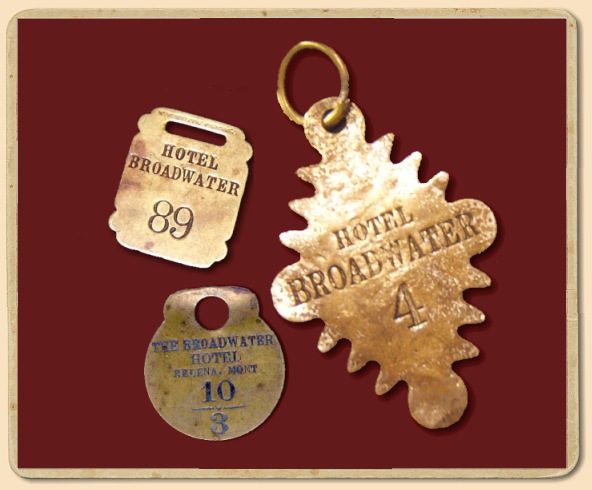
A
luggage tag (89) and two key fobs. The large No. 4 is a room
key,
the 10/3 is likely for one of the small separate units which
were built
west of the hotel in the 1920s.
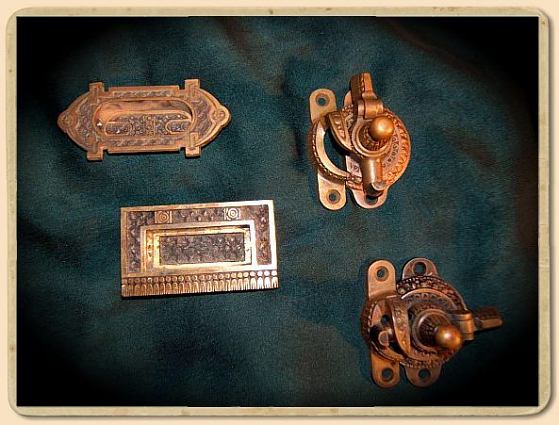
CLICK ON
THE OBJECTS FOR LARGER IMAGES OPENING IN NEW WINDOWS
Corbin
Lock Co. sash pulls and window locks from the Broadwater Hotel.
|
These
window pieces are a continuation of the Corbin"Brocade"
pattern. The sash pulls are the two types used on the
main floor of the hotel. The rectangular pattern was
used in most areas of the hotel, on both the first and
second floors. The more delicate oval-shaped pull was
used on the eastern sections of the hotel, primarily
in the spaces occupied by women. There is no proof that
the builders did this on purpose, but with the extent
to which detail was lavished on the building, I can
see this as perhaps being the case..
The
sash locks are the pattern that once again follows the
"Brocade" style. They have a wonderful mechanism
that to this day works like new. Hundreds of brass sash
locks and pulls were sold by the barrell-full at the
1974 Broadwater auction.
|
PHOTO
COURTESY OF SCOTT NELSON - THE
BRIDGEWORKS CONSERVANCY
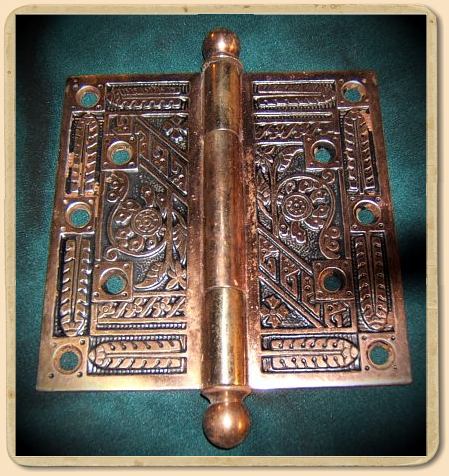
CLICK ON
THE IMAGE FOR A LARGER VERSION OPENING IN A NEW WINDOW
Corbin
Lock Co. hinge from the Broadwater Hotel.
|
For
some reason, the "Brocade" pattern used exclusively
throughout the
hotel was nixed when it came to the hinges. Once again
from Corbin, these "Wheat" patterned hinges
were a common style used in commercial applications
because of their size and heavy duty construction.
Interior doors of the hotel had these in solid brass,
while the exterior doors had a heavier brass-plated
steel in the same pattern. In 1889 Corbin suggests doing
so in their sales literature: "Doors of frequency
should utilize our brass plated steel hinge-work offered
only by Corbin" .
This was offered at the time by many other manufacturers,
and had evolved from steel pin receivers cast into the
sleeves during the 1840s to cast steel during the 1880s.
|
PHOTO
COURTESY OF SCOTT NELSON - THE
BRIDGEWORKS CONSERVANCY
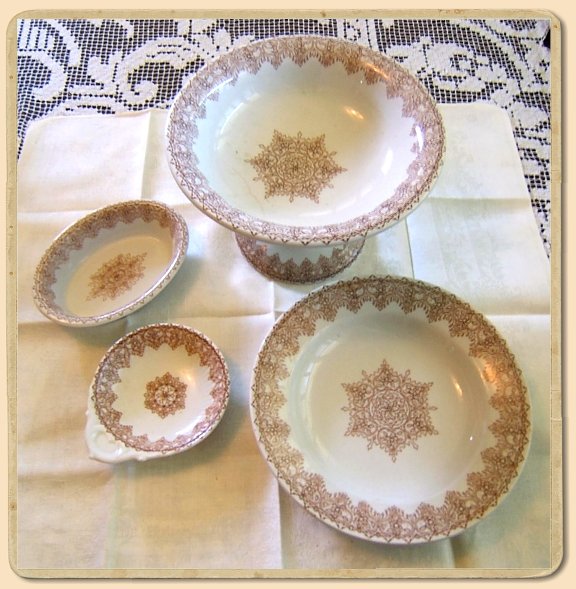
|
China
from the Broadwater Hotel. This early everyday service
was Red Lace Semi-Vitreous from the Greenwood Ceramic
Co. of Trenton, NJ. Three small cases of this china were
sold at the 1974 auction.
On
more formal occasions, tables were set with this pattern
in green, but augmented by the addition of a large ornate
letter B. Pieces of the green set are very rare today.
|
Scott Nelson of Helena relates this story about the china:
|
Hilda
Potter, born in 1906, worked in the hotel as a waitress
in 1934 while living in Rimini. She told me some of her
adventures….”We broke a lot of these”,
she told me holding a large Red Lace dinner platter. “You
could be clumsy and get away with it, if you had looks".
Hilda
went to the hotel a few days after the 1935 earthquake
to help staff clean up inside. “It was a mess”,
she said, “glass everywhere and some of the best
stuff all over the floor. We took most of the rubbish
and broken pottery out the back and threw it in by the
creek.”
Hilda
was a great lady with some amazing stories, she passed
a few
years ago, in her late 90s, but I will always remember
her mischievous early days at the hotel. She was a bit
of a kleptomaniac in her day, having amassed a small fortune
in trinkets she acquired thorough her life. She was a
really cool lady.
|
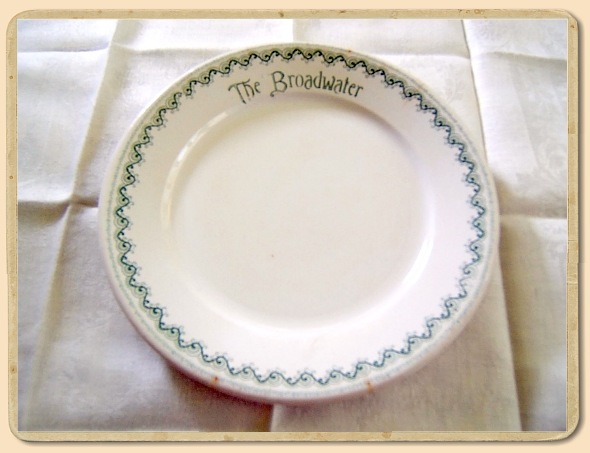
About
1900, this green semi-vitreous set was purchased for the Broadwater.
It was manufactured by the J & E Mayer Pottery Co. of Beaver
Falls, PA.
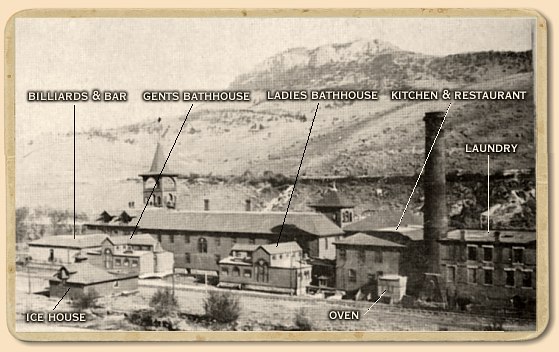
Rear
of the hotel, showing locations of several facilities.
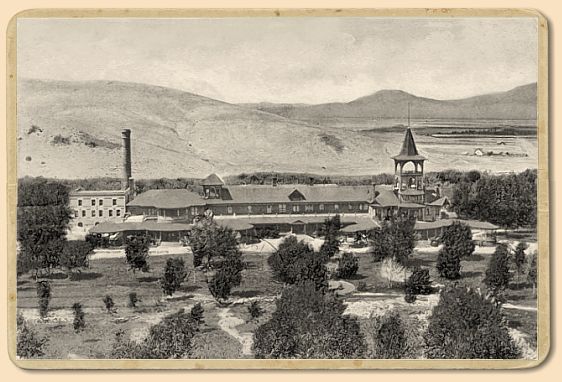
|
The
hotel operation was eventually downsized, and began catering
primarily to local residents. For some years, a restaurant
operated out of the hotel dining room, while the rest
of the building was closed off. The truncated hotel eventually
became a kind of glorified roadhouse, with neon lights,
gambling and dancing. Even that couldn't save it when
the State of Montana cracked down on gambling in 1941.
There was nothing left to do but close it.
During
World War II, there was a move to renovate the complex
with Federal money for use as a rest and recuperation
facility for returning soldiers. A $100,000 appropriation
was negotiated by the Mayor of Helena and the Commander
of the First Special Service Force at Fort Harrison, but
the plan was vetoed by the Helena Chamber of Commerce.
In
January of 1945, two Lewis & Clark County Legislators
announced that they would present a resolution asking
the assembly to investigate the feasibility of converting
the hotel into a home for the senile aged, in hopes of
alleviating overcrowding at the state hospital in Warm
Springs. This proposal did not come to fruition.
In
November of 1945, the 180-acre property was acquired by
miner Norman Rogers (1907-1993). At the time, Rogers
announced plans to remodel and open the hotel and the
plunge. He did put a new roof on the hotel, but that was
to be the extent of any conservation work. He used the
hotel and grounds primarily as a storage facility and
dumping ground for scrap.
In
July of 1946, Rogers threaded heavy steel cables through
the windows of the natatorium, attached them to a
bulldozer, and began pulling the structure down, leaving
the gigantic pool open to the elements. There were rumors
that the timbers and cedar paneling of the plunge were
subsequently sold for firewood. As late as 1948, Rogers
claimed that the plunge would soon re-open, but that never
came to pass.
Throughout
the years, Rogers' hostile "No Trespassing"
attitude was well-known to his neighbors, and to researchers
who vainly sought his cooperation in documenting the history
of the Broadwater.
In 1957, Rogers made an exception and allowed a Helena
native, movie star Gary
Cooper, to wander the grounds and reminisce. Those
without such caché were sternly turned away.
|
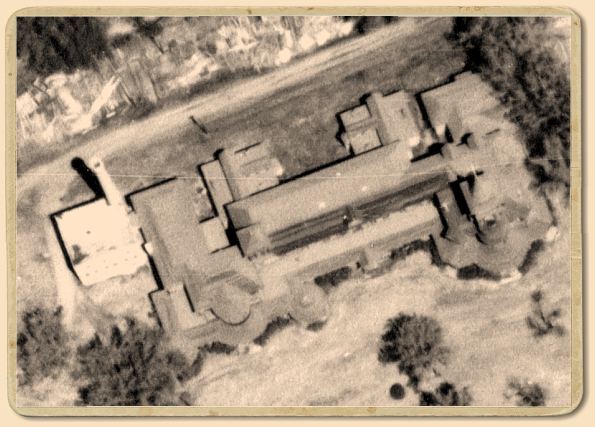
Aerial
view of the hotel, 1953. Click on it for a larger image in a
new window.
COURTESY
OF SCOTT NELSON - THE
BRIDGEWORKS CONSERVANCY
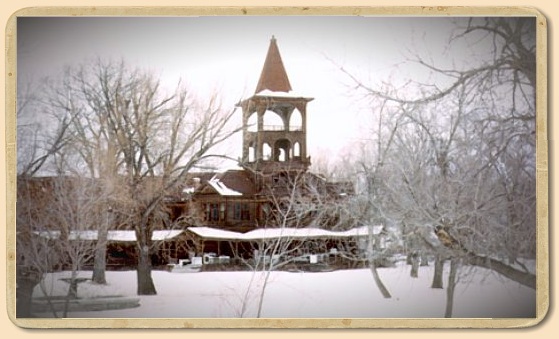
The
last days
Sagging
verandahs heaped with scrap.
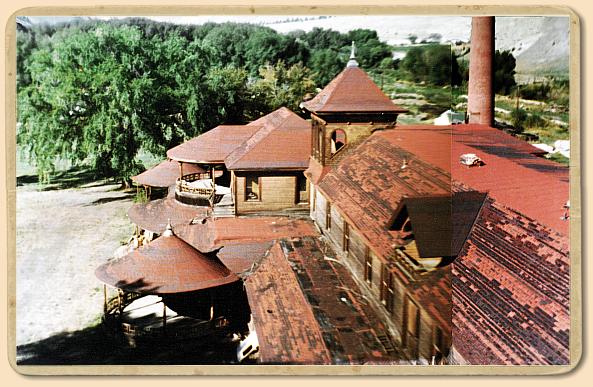
| Two
views
of the Broadwater Hotel one month before the public auction,
1974. Photo
taken from the observation tower, looking toward the west
cupola and brick smokestack. |
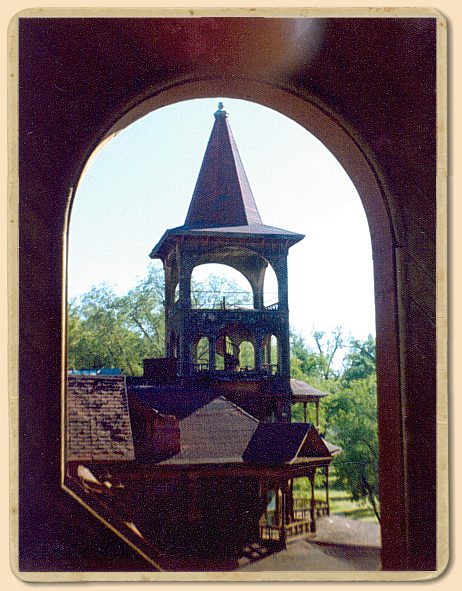
The
observation tower from the west cupola, 1974. The
spiral staircase can be seen.
COURTESY
OF SCOTT NELSON - THE
BRIDGEWORKS CONSERVANCY
|
In
1974, Norman Rogers put the remaining contents and salvageable
parts of the hotel up for public auction. It has since
been learned that not everything represented in the auction
as being part of the Broadwater actually was. Downtown
Helena was undergoing "Urban Renewal" in 1974,
and some architectural details from demolished Victorian
buildings found their way into the Broadwater auction.
Assisting today in correctly identifying Broadwater artifacts
is Scott
Nelson of The
Bridgeworks Conservancy.
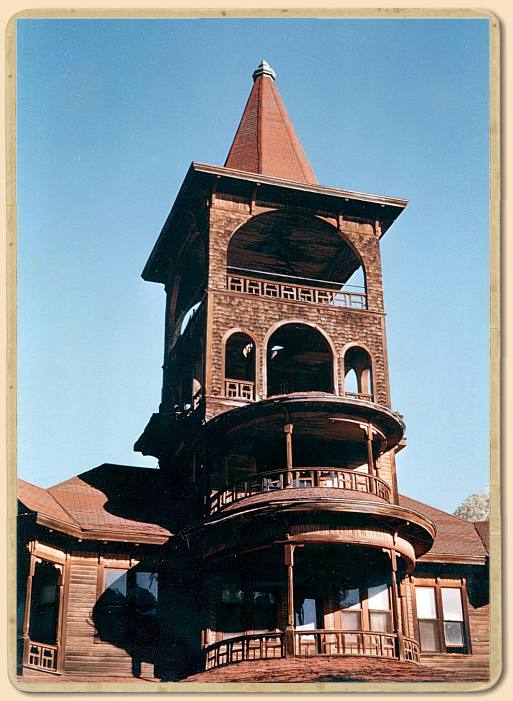
The
observation tower on auction day, 1974.
COURTESY
OF SCOTT NELSON - THE
BRIDGEWORKS CONSERVANCY

Auction day, 1974.
COURTESY
OF SCOTT NELSON - THE
BRIDGEWORKS CONSERVANCY
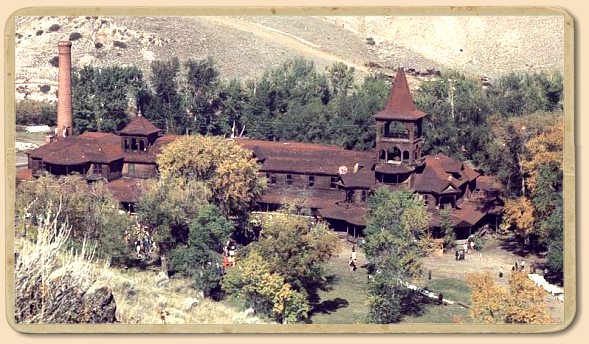
The
hotel on auction day, 1974.
COURTESY
OF SCOTT NELSON - THE
BRIDGEWORKS CONSERVANCY
Most
of the hotel structure was demolished in 1976, and demolition
was completed by 1989. All but three of the original buildings,
the observation tower, and the west copula, are gone.
The original structures still standing on the grounds
are the stone stable, the billiards room (which was part
of the hotel itself), and the carriage house.
The steepled cupola was purchased at the auction by father
and son Joseph B. and Joseph E. Reber, who donated it
to Lewis and Clark County. It was moved to the east side
of Helena, where it fell into disrepair. It was refurbished
in 2000 and placed in a small park just off Colonial
Drive, near Smith School. The west cupola was obtained
in 1976 by the Archie
Bray Foundation, a world-class ceramics studio located
about a mile from the Broadwater. The cupola may be visited
on the Foundation grounds. View these remaining structures
on the "The Broadwater
Today" page.
Today,
the land once occupied by the Broadwater is owned by Helena
resident, and former Montana Governor, Tim Babcock. He
has received praise for restoring and maintaining landscaping
on the site. Babcock often holds outdoor soirees for GOP
candidates on the spacious grounds.
|


|